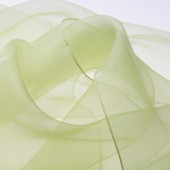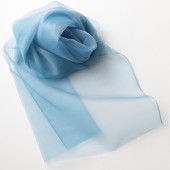Fairy Feather Fairy Feather the world's thinnest silk by Eita Saito |
Home > Winners > #54341 |
 |
|
||||
| DESIGN DETAILS | |||||
| DESIGN NAME: Fairy Feather PRIMARY FUNCTION: Fairy Feather the world's thinnest silk INSPIRATION: Though I made them feel silk beauty, gloss and poshness like a feather of a dragonfly, angel's feather and sprite's feather, I was particular about silk thinness and made it thoroughly. UNIQUE PROPERTIES / PROJECT DESCRIPTION: The fabric, so ethereal, makes us imagine the texture of the robes worn by the heavenly nymphs in Japanese folk tales. We named it Fairy Feather: the thinnest yarn-dyed silk fabric ever. It is made of ultra-fine silk threads with a thinness of 8 denier in diameter, equaling to 1/6 of the diameter of a hair (50 denier). Thousands of ultra-fine silk threads are woven into the warps on looms to produce this exquisite organdy (ultra-light plain-weave fabric with transparency); it is weightless, yet the softness of the raw silk gently, and surely, cocoons the skin. OPERATION / FLOW / INTERACTION: Yarn-Dyed Organdy Using the World’s Thinnest Thread Using silkworms that yield the world’s thinnest fibers (1.6 deniers), we have successfully spun the fibers into thread to create this product. Even with multiple strands, the thread is as thin as 8 deniers. The yarn-dyeing process gives shimmer, transparency and polarized chambray effect (iridescence in English) that are not possible with piece dyeing. The beautiful fabric is reminiscent of the northern lights. PROJECT DURATION AND LOCATION: A project has started with a plan for 5 years in January, 2011 in Japan. It'll be announced by a bridal collection and be a topic in 2014. FITS BEST INTO CATEGORY: Fashion, Apparel and Garment Design |
PRODUCTION / REALIZATION TECHNOLOGY: Silk 100% SPECIFICATIONS / TECHNICAL PROPERTIES: The Ultimate Silk Thread Our 8-denier silk thread is produced by using silkworms that emit the thinnest fibers in the world, which, at 1.6 deniers, are about half as thin as regular fibers. In comparison, a human hair has an average thickness of about 50 deniers. The threads are so thin that they feel virtually weightless in the hand. They are not available on the market nor are they distributed for general use. Using these 8-denier silk microfibers has made it possible to give the fabric a pleasantly clean and fresh appearance. * 8-denier: Measurement of linear mass density of fibers One denier is defined as the mass in grams per 9,000 meters. Said to be the thinnest at 8 deniers, our custom-ordered silk threads are a prized treasure. TAGS: silk, Fairy Feather, KAWAMATA, Light, Thin, Thin, JAPAN RESEARCH ABSTRACT: Between the research and the sale, it took four years of continuous development of this one-of-a-kind silk product. Even the cocoons that we use as raw material are special ones. Ordinarily, the cocoons to be used are the ones produced through four molts of silkworms; however, those used for Fairy Feather are made only through three molts and thus the fibers are finer and supple as spider's thread. The reason we ventured to use ultra-fine silk threads—something other companies hesitate over—is because, above all, fine, light fabrics have been very popular in the fashion world. Yet, the leading wedding dress designer Yumi Katsura, our business associate since 30 years, also gave us an important clue with these words: "I would like to make lightweight wedding dresses so that brides can dance lightly in comfort." We have continuously made various improvements on the looms, in order to make the fabric not only mass-producible by mechanical processes, but also non-breakable and fuzz-free in heavy weaving movements of the loom, even when using the ultra-fine yarns made form the three-molt silkworms. By strictly controlling the tension of the threads, we finally managed to make the fabric into a commercial product: the Fairy Feather was thus born. CHALLENGE: Dealing with thin silk fabric can be tricky as it can pile easily and create slight yet noticeable imperfections of the weave. Interlacing super-fine threads that are almost invisible to the human eye requires years of experience and knowledge. Our team of skilled artisans weaves the fabric with much care and attention. ADDED DATE: 2017-02-22 06:49:12 TEAM MEMBERS (2) : YASUYUKI SAITO and KANAI SHIRO IMAGE CREDITS: Eita Saito, 2016. PATENTS/COPYRIGHTS: There are no patents. Technological, to have, more, intellectual properties are being defended. |
||||
| Visit the following page to learn more: http://www.nippon.com/en/views/b00603/ | |||||
| AWARD DETAILS | |
 |
Fairy Feather Fairy Feather The World's Thinnest Silk by Eita Saito is Winner in Textile, Fabric, Textures, Patterns and Cloth Design Category, 2016 - 2017.· Read the interview with designer Eita Saito for design Fairy Feather here.· Press Members: Login or Register to request an exclusive interview with Eita Saito. · Click here to register inorder to view the profile and other works by Eita Saito. |
| SOCIAL |
| + Add to Likes / Favorites | Send to My Email | Comment | Testimonials | View Press-Release | Press Kit |
Did you like Eita Saito's Textile Design?
You will most likely enjoy other award winning textile design as well.
Click here to view more Award Winning Textile Design.








